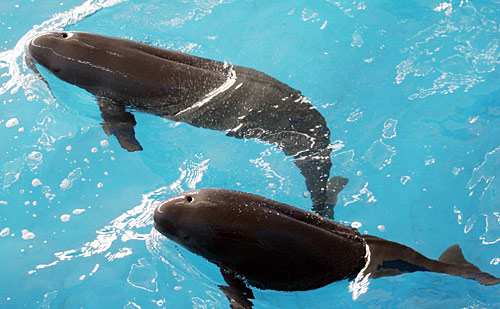|
 |
|
GROWING HEALTHILY: The world's first finless porpoise bred by artificial insemination swims together with its mother on March 6, 2006 (JIN SILIU) |
The finless porpoise in the Yangtze River may die out in the next 15 years, and they are decreasing at a rate of 5 percent annually, said Wang Ding, a researcher with the Institute of Hydrobiology (IHB) of the Chinese Academy of Sciences (CAS). The future of the porpoise worries Wang. Measures must be taken to protect their habitat—or they may even die out earlier, he said.
A survey shows the river's finless porpoise population was 2,700 in 1984. The number fell to 1,800 in 2006, and now it numbers less than 1,500.
The finless porpoise, which is extremely sensitive to water quality, has lived for as long as 25 million years in the Yangtze River. Its life-span is about 20 years. "For thousands of years, they have lived on top of the food chain in rivers and lakes, so they are totally free of fear of danger," said Hao Yujiang, a researcher with IHB.
However, because of human activities, the finless porpoise's living environment is being threatened, and irregular deaths of the creature have become very common in recent years. Excessive development along the bank of the Yangtze River has caused severe water pollution. Some dams have cut off the porpoise's migratory passages. Noise made by intensive ship activity has disturbed the porpoise's sonar systems, causing neurasthenic problems of the creature. Propellers sometimes unexpectedly kill them.
"Reckless fishing has resulted in food shortages for the porpoise, and thus fishing should be completely banned in the Yangtze valley for at least 10 years," said Cao Wenxuan, an academician at the CAS.
Scientists said it is very possible to impose a 10-year fishing ban, because annual fishing output in the Yangtze River, which is around 100,000 tons, accounts for less than 1 percent of the total turnout of freshwater fishery (including aquaculture) in China.
The fate of white-fin dolphin
The white-fin dolphin, which lived in the Yangtze River for up to 25 million years, had played the role of flagship species of the river's aquatic life system. The species has disappeared in recent years. Scientists think the porpoise may eventually go the way of the white-fin dolphin.
At the end of 2006, Wang joined in an international joint study group, comprising more than 20 world-class cetacea experts from the United States, Japan, China and other countries.
The expert group for the first time introduced a high-precision acoustic method in the largest study of the dolphin along the river.
After one month's study involving in a round trip about 3,000 km, scientists found no trace of the dolphin at all. This means the creature, a species rarer than the giant pandas, is likely to have become extinct. It is also the first large vertebrate to have possibly disappeared on the Earth during the past 50 years.
Although the International Union for Conservation of Nature guidelines says if individuals of a species have not been seen in the wild for 50 years, it could be declared extinct, experts believe the white-fin dolphin is functionally extinct, as it has lost population reproduction capacity because of small numbers.
| 